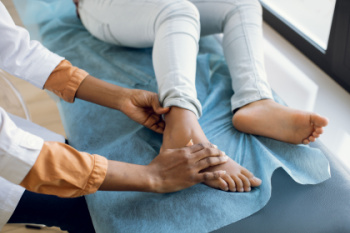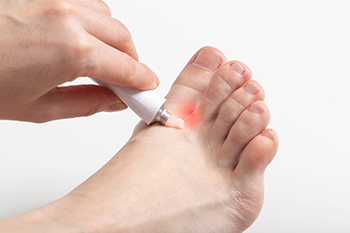
Peripheral artery disease, or PAD, affects millions of individuals in the United States. It is caused by reduced blood flow due to plaque buildup in peripheral arteries. PAD often targets the lower extremities, seriously affecting the legs and feet. A common indicator of peripheral artery disease is intermittent muscle pain in the lower legs during activity that subsides with rest. Other signs include diminished toenail and leg hair growth, temperature disparities between feet and non-healing wounds. Treatment from a podiatrist is essential for alleviating symptoms and preventing further complications. Podiatrists can offer various treatment options for PAD, including custom orthotic devices and footwear modifications, and in severe cases, surgical intervention. Additionally, lifestyle adjustments, such as smoking cessation and managing underlying conditions like hypertension, are essential in PAD management. Early intervention not only improves quality of life but also reduces the risk of severe complications associated with PAD. If you experience symptoms of peripheral artery disease that is affecting your lower legs and feet, it is suggested that you schedule an appointment with a podiatrist.
Peripheral artery disease can pose a serious risk to your health. It can increase the risk of stroke and heart attack. If you have symptoms of peripheral artery disease, consult with Dr. Thomas E. Silver from Westwood Foot Clinic. Our doctor will assess your condition and provide you with quality foot and ankle treatment.
Peripheral artery disease (PAD) is when arteries are constricted due to plaque (fatty deposits) build-up. This results in less blood flow to the legs and other extremities. The main cause of PAD is atherosclerosis, in which plaque builds up in the arteries.
Symptoms
Symptoms of PAD include:
- Claudication (leg pain from walking)
- Numbness in legs
- Decrease in growth of leg hair and toenails
- Paleness of the skin
- Erectile dysfunction
- Sores and wounds on legs and feet that won’t heal
- Coldness in one leg
It is important to note that a majority of individuals never show any symptoms of PAD.
Diagnosis
While PAD occurs in the legs and arteries, Podiatrists can diagnose PAD. Podiatrists utilize a test called an ankle-brachial index (ABI). An ABI test compares blood pressure in your arm to you ankle to see if any abnormality occurs. Ultrasound and imaging devices may also be used.
Treatment
Fortunately, lifestyle changes such as maintaining a healthy diet, exercising, managing cholesterol and blood sugar levels, and quitting smoking, can all treat PAD. Medications that prevent clots from occurring can be prescribed. Finally, in some cases, surgery may be recommended.
If you have any questions, please feel free to contact our office located in Golden Valley, MN . We offer the newest diagnostic and treatment technologies for all your foot care needs.
 Chronic foot pain can result from many conditions, including plantar fasciitis, arthritis, diabetes-related neuropathy, and repetitive stress injuries. These conditions can lead to ongoing discomfort, affecting mobility and quality of life. Effective diagnosis often begins with a comprehensive evaluation by a podiatrist, who will review the patient’s medical history and conduct a physical examination. Podiatrists may utilize imaging tests like X-rays, MRIs, or CT scans to view the internal structure of the foot and identify any underlying issues. These tests help the doctor confirm or eliminate certain conditions from the diagnosis by giving a detailed picture of what is happening in the foot. Gait analysis might also be performed to assess how the individual stands and walks, pinpointing abnormal movements that could contribute to the pain. Getting the right diagnosis is important so the podiatrist can create a customized treatment strategy to address the chronic pain. If you are suffering from chronic foot pain, it is suggested that you make an appointment with a podiatrist today.
Chronic foot pain can result from many conditions, including plantar fasciitis, arthritis, diabetes-related neuropathy, and repetitive stress injuries. These conditions can lead to ongoing discomfort, affecting mobility and quality of life. Effective diagnosis often begins with a comprehensive evaluation by a podiatrist, who will review the patient’s medical history and conduct a physical examination. Podiatrists may utilize imaging tests like X-rays, MRIs, or CT scans to view the internal structure of the foot and identify any underlying issues. These tests help the doctor confirm or eliminate certain conditions from the diagnosis by giving a detailed picture of what is happening in the foot. Gait analysis might also be performed to assess how the individual stands and walks, pinpointing abnormal movements that could contribute to the pain. Getting the right diagnosis is important so the podiatrist can create a customized treatment strategy to address the chronic pain. If you are suffering from chronic foot pain, it is suggested that you make an appointment with a podiatrist today.
Foot Pain
Foot pain can be extremely painful and debilitating. If you have a foot pain, consult with Dr. Thomas E. Silver from Westwood Foot Clinic. Our doctor will assess your condition and provide you with quality foot and ankle treatment.
Causes
Foot pain is a very broad condition that could be caused by one or more ailments. The most common include:
- Bunions
- Hammertoes
- Plantar Fasciitis
- Bone Spurs
- Corns
- Tarsal Tunnel Syndrome
- Ingrown Toenails
- Arthritis (such as Gout, Rheumatoid, and Osteoarthritis)
- Flat Feet
- Injury (from stress fractures, broken toe, foot, ankle, Achilles tendon ruptures, and sprains)
- And more
Diagnosis
To figure out the cause of foot pain, podiatrists utilize several different methods. This can range from simple visual inspections and sensation tests to X-rays and MRI scans. Prior medical history, family medical history, and any recent physical traumatic events will all be taken into consideration for a proper diagnosis.
Treatment
Treatment depends upon the cause of the foot pain. Whether it is resting, staying off the foot, or having surgery; podiatrists have a number of treatment options available for foot pain.
If you have any questions, please feel free to contact our office located in Golden Valley, MN . We offer the newest diagnostic and treatment technologies for all your foot care needs.
 Athlete's foot is a fungal infection that affects the skin of the feet. It's caused by various types of fungi that thrive in warm, moist environments. Athlete’s foot is commonly contracted in places such as locker rooms, swimming pools, and communal showers. When the feet are exposed to these fungi, they can easily penetrate the skin, leading to the development of athlete's foot. Factors such as wearing tight or poorly ventilated shoes, sweating excessively, or having a weakened immune system can increase the risk of developing athlete’s foot. Athlete’s foot is highly contagious and can spread through direct contact with infected skin or by sharing contaminated items like towels or shoes. Symptoms of athlete's foot include itching, redness, and peeling of the skin between the toes or on the soles of the feet. Podiatrists, or foot doctors, are well-equipped to diagnose and treat athlete's foot. They may offer treatments, such as antifungal medications and topical treatments to help patients find relief. If you suspect athlete’s foot, it is suggested that you consult a podiatrist for prompt treatment.
Athlete's foot is a fungal infection that affects the skin of the feet. It's caused by various types of fungi that thrive in warm, moist environments. Athlete’s foot is commonly contracted in places such as locker rooms, swimming pools, and communal showers. When the feet are exposed to these fungi, they can easily penetrate the skin, leading to the development of athlete's foot. Factors such as wearing tight or poorly ventilated shoes, sweating excessively, or having a weakened immune system can increase the risk of developing athlete’s foot. Athlete’s foot is highly contagious and can spread through direct contact with infected skin or by sharing contaminated items like towels or shoes. Symptoms of athlete's foot include itching, redness, and peeling of the skin between the toes or on the soles of the feet. Podiatrists, or foot doctors, are well-equipped to diagnose and treat athlete's foot. They may offer treatments, such as antifungal medications and topical treatments to help patients find relief. If you suspect athlete’s foot, it is suggested that you consult a podiatrist for prompt treatment.
Athlete’s Foot
Athlete’s foot is often an uncomfortable condition to experience. Thankfully, podiatrists specialize in treating athlete’s foot and offer the best treatment options. If you have any questions about athlete’s foot, consult with Dr. Thomas E. Silver from Westwood Foot Clinic. Our doctor will assess your condition and provide you with quality treatment.
What Is Athlete’s Foot?
Tinea pedis, more commonly known as athlete’s foot, is a non-serious and common fungal infection of the foot. Athlete’s foot is contagious and can be contracted by touching someone who has it or infected surfaces. The most common places contaminated by it are public showers, locker rooms, and swimming pools. Once contracted, it grows on feet that are left inside moist, dark, and warm shoes and socks.
Prevention
The most effective ways to prevent athlete’s foot include:
- Thoroughly washing and drying feet
- Avoid going barefoot in locker rooms and public showers
- Using shower shoes in public showers
- Wearing socks that allow the feet to breathe
- Changing socks and shoes frequently if you sweat a lot
Symptoms
Athlete’s foot initially occurs as a rash between the toes. However, if left undiagnosed, it can spread to the sides and bottom of the feet, toenails, and if touched by hand, the hands themselves. Symptoms include:
- Redness
- Burning
- Itching
- Scaly and peeling skin
Diagnosis and Treatment
Diagnosis is quick and easy. Skin samples will be taken and either viewed under a microscope or sent to a lab for testing. Sometimes, a podiatrist can diagnose it based on simply looking at it. Once confirmed, treatment options include oral and topical antifungal medications.
If you have any questions, please feel free to contact our office located in Golden Valley, MN . We offer the newest diagnostic and treatment technologies for all your foot care needs.

